U.S. Department of Transportation
Federal Highway Administration
1200 New Jersey Avenue, SE
Washington, DC 20590
202-366-4000
FHWA Resource Center
Office of Innovation Implementation
Volume 3, Issue 4
October 2007
Letter from the Editor
Dear Reader
As we welcome Autumn, we have put together an issue of Environmental Quarterly that touches on several interesting topics including Design Build Contracting, Context Sensitive Solutions and the Transportation Research Board (TRB). We hope that you find this issue informative.
As always, if you have comments about a story or story ideas, please let us know.
Sincerely,
Don Cote
Resource Center (RC), Environment Technical Service Team (TST) Leader & Editor–in-Chief
Phone: (720) 963-3210
E-mail: Don.Cote@fhwa.dot.gov
INSIDE
• Revised Design Build Contracting Regulation…p. 1
• Context Sensitive Solutions…p.4
• ADC40 Transportation Noise and Vibration Meeting…p. 5
• ADC50 - Committee on Historic &Archaeological Preservation in Transportation Meeting …p.6
• Training Opportunities...p.7
• Environmental Calendar...p.8
Federal Highway Administration Issues Revised Design-Build Contracting Regulation
By Jeff Lewis and Mary Ann Rondinella, FHWA RC
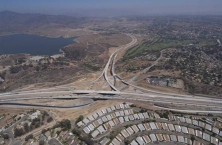
Design Build Project example. Looking South, SR 125 South Toll road Mainline Toll Plaza southern terminal, approx 1 mile north of the SR 905 Otay Mesa Port-of Entry (POE) at the U.S/Mexico Border. (Photo courtesy of Caltrans District 11.
Contracting Agencies Can Award Design-Build Contracts Prior to Completion of the National Environmental Policy Act Review
On August 14, 2007, the Federal Highway Administration (FHWA) published a final rule revising its design-build contracting regulation. The revisions were mandated by Section 1503 of the Safe, Accountable, Flexible, Efficient Transportation Equity Act: A
Legacy for Users (SAFETEA-LU). FHWA had issued a notice of proposed rulemaking on May 25, 2006. The final rule includes responses to several comments on the proposed rule. The final rule amends parts 630, 635 and 636 of title 23, Code of Federal Regulations (23 CFR 630, 635 and 636.) The final rule became effective on September 13, 2007.
What is design-build contracting?
The traditional process for building highway projects is called the design-bid-build process. Under this process, state departments of transportation (DOT) or local agencies are responsible for completing environmental studies and preliminary and final designs, using in-house staff or consultants, or a combination thereof. A plans, specifications and estimate (PS&E) package is prepared, and then the project is advertised for construction bids. Typically, the construction contract is awarded to the firm offering the lowest responsive bid.
Design-build contracting is fundamentally different. While the State DOT or local agency remains responsible for completion of environmental studies, they do not prepare PS&E packages. Instead, the contracting agencies issue Requests for Qualifications (RFQ) and Requests for Proposals (RFP) for a single contract for both design and construction. The design-build contract can be awarded on the basis of cost and other factors, including the qualifications of the responding firms.
How is the revised design-build regulation different from the previous one?
Under the previous regulation, design-build contracts exceeding a certain dollar threshold required FHWA approval under a Special Experimental Project (SEP-14). SAFETEA-LU abolished that threshold.
The previous regulation required contracting agencies to complete the National Environmental Policy Act (NEPA) review process prior to issuing RFP’s. In other words, a categorical exclusion (CE) determination or Finding of No Significant Impact (FONSI), or Record of Decision (ROD) was required prior to issuance of the RFP. Under the revised regulation, contracting agencies have more flexibility. They can now issue the RFP and award the contract before the NEPA process is completed. The contracting agencies can allow design-build contractors to conduct preliminary design activities. These activities can include design and engineering activities for the purposes of defining the project alternatives and NEPA alternatives analysis.
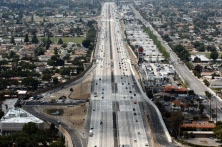
If the contracting agency awards the contract before the NEPA process is completed, certain conditions must be met.
What conditions apply to design-build contracts awarded before the NEPA process is completed?
The contracting agency must receive prior FHWA Division Office concurrence before issuing the RFP and awarding the contract. Also, the design-build contract must include provisions preventing the contractor from proceeding with final design or construction activities prior to the completion of the NEPA process, pursuant to the FHWA NEPA regulation at 23 CFR 771.113(a).
The design-build contract must include termination provisions in the event the no-build or no action alternative is selected at the end of the NEPA process.
Where does the revised regulation address design-build contracting and the NEPA process?
The revised regulation addresses the NEPA process at 23 CFR 636.109.
Where can I get a copy of the final rule and learn more about design-build contracting?
The final rule can be viewed at https://www.fhwa.dot.gov/programadmin/contracts/fedreg071408.cfm
Also, see the September 2007 “Successes in Streamlining” Newsletter at http://environment.fhwa.dot.gov/strmlng/newsletters/sep07nl.asp
Questions regarding the rule can be directed to Gerald (Jerry)Yakowenko at the FHWA Office of Program Administration, Gerald.Yakowenko@dot.gov, (202) 366-1562.
Questions regarding design-build contracting and the NEPA process can be directed to Lamar Smith at the FHWA Office of Project Development and Environmental Review, Lamar.Smith@dot.gov, (202) 366-8994.
Jeff Lewis – Major Projects Engineer
Construction and Project Management Technical Service Team
FHWA Resource Center
Phone number: (916) 498-5035
Mary Ann Rondinella -- Environmental Program Specialist
FHWA RC Environment TST
Phone number: (720) 963-3207
Federal Highway Administration announces 2007 Exemplary Ecosystem Initiatives! By Mary Ann Rondinella, FHWA Resource Center, Environment TST
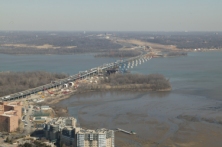
Photo of the Woodrow Wilson Bridge, the first EEI spanning three states. (Virginia Department of Transportation photo)
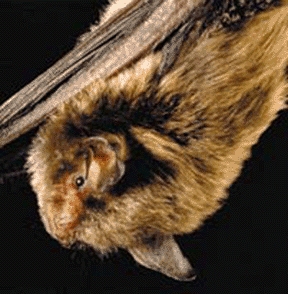
The Indiana bat is an endangered species. (U.S. Fish and Wildlife Service photo)
FHWA congratulates the following nine states and Division Offices for their Exemplary Ecosystem Initiatives. Look for more information about these initiatives in the January 2008 Environmental Quarterly!
Arkansas: Priority Conservation Initiatives and Ecosystem Recovery Plan for the Endangered Fat Pocketbook Mussel
Colorado: Strategic Transportation Environmental and Planning Process for Urbanizing Places (STEP-UP)
Maine: Connecting Transportation and Habitat
New York: Green and Blue Highways
Ohio: Indiana Bat Programmatic Consultation
Pennsylvania: Selinsgrove Center Mitigation Site
District of Columbia, Maryland and Virginia:
Woodrow Wilson Bridge-Environmental Initiatives, Management and Mitigation
Context Sensitive Solutions Support Team
By K. Lynn Berry, FHWA Resource Center, Environment TST
Context Sensitive Solutions (CSS) is recognized as an efficient, effective process for making balanced transportation decisions and it continues to gain momentum in the industry. FHWA has endeavored to provide the greatest support possible to ensure that CSS principles and methodologies are fully institutionalized in our Divisions and our partner organizations. One way we have done so is through the formation of the CSS Support Team, composed of advocates and experts from the Resource Center (Environment and Safety and Design TSTs); Headquarters (Planning, Environment, and Infrastructure) as well as Federal Lands.
The members of the Support Team recently spearheaded an agency-wide “self-assessment” process in which each Division office worked with their State DOT counterparts to evaluate their own success against several CSS performance measures. In so doing, the partners identified their strengths and weakness, and had good discussions about what they might need to do to achieve even greater success in the future, further identifying what sort of technical support might be necessary to meet their new goals. The results of these self-assessments were reviewed, discussed, and calibrated by the Support Team members, who provided a nationwide perspective and comparative knowledge of the respondents’ various programs. The primary purpose of this exercise was to determine how best to allocate agency resources so that Divisions & States can continue advancing – to reach the next level of success.
The Support Team will now oversee multiple contracts with consultants and with the AASHTO Center for Environmental Excellence, as well as “in-house” expertise from the Resource Center, Headquarters and Federal Lands. Support for action planning, peer exchanges, training, executive briefings, and technical assistance will be provided. Additionally, two guides and assessment tools are in production, for training as well as integration strategies. With the financial and technical support available, there is little doubt that Fiscal Year 2008 will prove to be a banner year for mainstreaming CSS in our programs, policies and projects.
K. Lynn Berry
FHWA RC Environment TST
Klynn.berry@fhwa.dot.gov
For more information:
http://environment.transportation.org/environmental_issues/context_sens_sol/
Central Federal Lands Highway Division Recognized as Outstanding Project Management Organization
By Mary Ann Rondinella, FHWA RC, Environment TST
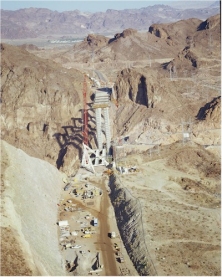
This photo shows the Colorado River bridge under construction, a part of CFLHD’s complex Hoover Dam Bypass project. (CFLHD photo)
The Project Management Institute has recognized Central Federal Lands Highway Division (CFLHD) as a 2007 Outstanding Organization. CFLHD was recognized for its ability to manage complex projects utilizing a cross-functional matrix team structure, earned value performance controls, and a focus on training and certification. This has resulted in improved project delivery and process controls.
The Environmental Quarterly congratulates CFLHD for this prestigious recognition! Look for more information about CFLHD’s project management program in the January 2008 issue!
ADC40 Transportation Noise and Vibration Summer Meeting Showcases Best Practices and New Technologies
By Mary Ann Rondinella, FHWA Resource Center, Environment Technical Service Team
The Transportation Research Board ADC40 Committee on Transportation-Related Noise and Vibration Summer Meeting on July 22-25, 2007. The meeting was hosted by the California Department of Transportation (Caltrans) in beautiful and historic San Luis Obispo in Central California. The meeting featured a number of presentations covering a broad spectrum of topics, including public involvement, tire-pavement noise, construction noise, and civil and military aircraft noise. The meeting also featured exhibits from vendors showcasing noise measurement and abatement technologies.
Ulf Sandberg of the Swedish National Road and Transport Research Institute and Jorgen Kragh of the Danish Road Institute brought an international perspective. Mr. Sandberg reported on a review of quiet pavement studies in Europe and Asia. Mr. Kragh presented a paper on a system of classifying low noise road surfaces. He also presented the results of a pilot study of low noise rumble strips.
Tire-pavement noise was the subject of several presentations at this year’s meeting. Paul Donovan and Aaron Hastings reported on recent studies on heavy trucks. Previous studies have primarily focused on passenger vehicles. The contribution of heavy trucks to tire-pavement noise has not been well-understood. While truck exhaust and engine noise are major noise sources, recent studies indicate that heavy trucks generate high noise levels closer to the vehicle/pavement interface.
A new public involvement tool generated a great deal of attention from participants. “The Little Book of Quieter Pavements” provides information about the role that tire-pavement noise plays in the overall problem of traffic noise. It is accompanied by an interactive demonstration that allows listeners to hear different types and levels of highway traffic noise generated by different pavement types.
Also generating a great deal of interest was the vehicle-mounted, onboard sound intensity (OBSI) equipment that was on display in the parking lot outside the host hotel. Attendees had the opportunity to examine the equipment up-close and ask researchers questions about OBSI measurements. Caltrans pioneered the use of OBSI measurement to study tire-pavement noise generated by moving vehicles. The technique is now used by other State DOT’s and research teams. More information about tire-pavement noise research can be found at https://www.fhwa.dot.gov/ENVIRonment/noise/tp_noise.htm
Mia Waters of the Washington State DOT gave a presentation on outreach to the public, elected officials and the media. She also reported on the impact of studded snow tires on tire-pavement noise levels.
Mark Ferroni of FHWA Headquarters gave an overview of FHWA activities. He reported on plans to develop an update to the FHWA Traffic Noise Model, TNM 3.0. He also reported on plans to update the FHWA noise regulations.
Meeting attendees recognized Dr. Judith Rochat of the U.S. Department of Transportation Volpe Center for her hard work in organizing a most productive and educational conference.
For more information about ADC40 and the summer meeting, visit the ADC40 website at http://www.adc40.org/
Mark Ferroni, Team Manager
FHWA Noise Team, HEPN
Mark.Ferroni@dot.gov
Mary Ann Rondinella,
FHWA RC Environment TST
MaryAnn.Rondinella@fhwa.dot.gov
ADC50 - Committee on Historic and Archaeological Preservation in Transportation Summer Meeting
By Stephanie M. Stoermer, FHWA Resource Center, Environment Technical Service Team
The Transportation Research Board (TRB) Committee on Historic and Archaeological Preservation in Transportation (ADC50) Summer Meeting was held in Flagstaff, Arizona from July 22 through 25, 2007. It was evident from both the quality and quantity of the information provided in the Built Environment and Archeology Tracks that a great deal of time and thoughtful preparation was invested in planning the meeting.
As the title of the meeting, “Roads, Railroads and Ruins: Navigating Historic Preservation in Transportation Projects” indicates, participants were treated to a robust program of informative sessions related to archeology and the built environment issues in a transportation setting. Topical areas included the curation of archeological materials, collaborative approaches, tribal perspectives, treatment of linear resources such as historic railroads and tunnels, roadside architecture, and evaluating post-World War II suburban historic resources.
Various approaches used by federal and state agencies, Indian tribes, and curatorial facilities to grapple with the ongoing “Curation Crisis” were the major focus of several Archaeology Track sessions. Although the “crisis” was initiated at the beginning of 20th Century with the passage of the Antiquities Act of 1906, it dramatically accelerated after the National Environmental Policy Act (NEPA), the National Historic Preservation Act (NHPA) and other laws of were passed. As a result of archeological mitigation activities associated with Federal undertakings, the capacity of repositories to accept new collections, or even adequately care for existing collections, has been repeatedly called into question over the past several decades.
This was timely and relevant topic, particularly for participants representing the State Departments of Transportation (SDOTs) who may be facing increasingly difficult choices when it comes to managing archeological collections generated by compliance activities related to transportation projects. Under Title 23, United States Code, for federal-aid highway projects the SDOTs are the responsible agencies for all aspects of project development, including environmental review and archeological survey work before and during construction. The SDOTs are also responsible for the long-term curation of archeological materials recovered from federal-aid transportation projects.
According to FHWA’s Guidance on the Consideration of Historic and Archeological Resources in the Highway Project Development (1988), the FHWA fulfills its historic and archeological preservation responsibilities when data has been recovered, analyzed and reported. However, despite the fact that, unlike federal land-managing agencies, the FHWA does not participate in the long-term curation of historical and archeological materials, it remains important for the FHWA to keep abreast of current trends in curation since this issue can affect how cultural resource investigations for federal-aid transportation projects are designed, managed, and carried out.
The Curation Crisis sessions provided valuable insight regarding how SDOTs such as the California Department of Transportation (Caltrans) and the Pennsylvania Department of Transportation (PennDOT) are addressing curation responsibilities, and also provided the opportunity to learn how federal agencies such as the National Park Service (NPS); the Department of Defense (DOD); the Bureau of Reclamation (BR) and the U.S. Army Corps of Engineers (COE) handle federal collections management. The cross-cultural perspective provided by both the Zuni Cultural Resource Enterprise (ZCRE) and the Navajo Nation Tribal Archeologist was particularly enlightening, as was the “international’ perspective provided by the Ontario Ministry of Transportation.
Critical issues such as rising costs, shrinking repositories, adequate standards of documentation and care for archeological collections, deaccessioning, and the deliberate reburial of materials were examined from several different perspectives by very knowledgeable presenters. A forum and open discussion that followed the Curation Crisis presentations were well-attended and were greatly enhanced by the interesting and thought-provoking sessions that preceded them.
Stephanie Stoermer,
FHWA RC Environment TST
Stephanie.Stoermer@fhwa.dot.gov
The new NCHRP problem statement 2009-B-19 - 'Best Practices for Curation of Archaeological Collections' is now available. Below is the direct link to view the problem statement.
http://www.trb.org/NCHRPBalloting/DocThread.asp?clsbtn=on&CandidateId=710
Roadside Weed Management Reference Available
By Bonnie Harper-Lore, FHWA Headquarters Office of Planning, Environment & Realty
Now available, a new reference applicable to all agencies and landowners. A partnership of three agencies developed the book with the help of national and State experts to go beyond the law and policy of weeds, to the applied science of weed control and management.
The book supports integrated management approaches, partnerships, and many future successes in the “war on weeds”. All States are involved, as well as the federal agencies who work within those boundaries. The book gives a quick interpretation of State and Federal laws in each State, as well as plant lists and available resources.
For your copy or copies, call the FHWA warehouse at (301) 322-5377.
REMINDER!
The deadline for submisssions to the 2007 PHOTO OPPORTUNITY CONTEST held by the Green Roadsides newsletter is November 10. Contact Bonnie Harper Lore for rules and information at Bonnie.Harper-Lore@fhwa.dot.gov.
Categories include: Planted Native wildflowers/grasses, Planted Nonnative wildflowers, Protection, Public Awareness, Close-up, Vegetation Management, Invasive Plants, Environmental Stewardship or Innovation, and Neighbors
• Send no more than 3 photos per category.
• Each State may enter any one or all categories.
• Districts or individuals may enter through their State Office.
• Type a cover letter about the program and the back-of-photo
information for legibility, please.
• Submit 8x10 photos. These photos become the property of our files
for use in FHWA brochures, public awareness, etc. Will post on Web soon.
• Provide a brief description on the back of each photo (date, hwy. location, goal and/or names of key plants, State name and category. Photographer if known.
• Protect in plastic sleeves (in a 3 hole binder) when mailing.
• Submissions are due on November 10, 2007.
• Send to the Editor at FHWA, 380 Jackson St., Suite 500, St. Paul, MN 55101-2904. We suggest using a trackable method of mailing.
A multidisciplinary jury will review and determine winners in December. Winners will be notified as soon as possible following the selection. Any questions should be directed to Bonnie L. Harper-Lore, Greener Roadsides, Editor, 651-291-6104.
What's Going On?
Here are a few of the upcoming events of interest to the environmental community:
October 2007
October 29-November 3
2007 NORTH AMERICAN LAKE MANAGEMENT SOCIETY (NALMS) INTERNATIONAL SYMPOSIUM
Orlando, FL
http://www.nalms.org/Conferences/Orlando/Default.aspx
November 2007
November 4
End of Daylight Saving Time
January 2008
January 13 - 17
TRB 87th Annual Meeting - "Partnerships for Progress in Transportation"
Washington, DC
Contact: TRB's Linda Karson at LKarson@nas.edu
March 2008
March 13-14
GREENPRINTS 2008: SUSTAINABLE COMMUNITIES BY DESIGN
Atlanta, GA.
http://www.greenprints.org/
For additional conferences and events, see FHWA's Planning, Environment & Realty calendar at www.fhwa.dot.gov/hep/calendar.htm.
CONTACT INFORMATION:
Editor–in-Chief
Don Cote
Environment Technical Service Team (TST)
Team Manager
Phone: (720) 963-3210
don.cote@fhwa.dot.gov
Environment TST Editorial Board Members:
David Grachen, Brian Smith, Stephanie Stoermer and David Sullivan
FHWA Resource Center
Aung Gye
Office of Project Development &
Environmental Review, FHWA HQ
Managing Editor:
Marie Roybal,
FHWA Resource Center
marie.roybal@fhwa.dot.gov
Due to Quarterly publication schedule, all article submissions for future issues are due to the Editor-In-Chief by the 15th of March, June, September, and/or December
If you would like to receive this newsletter electronically, please send your email address to: marie.roybal@fhwa.dot.gov